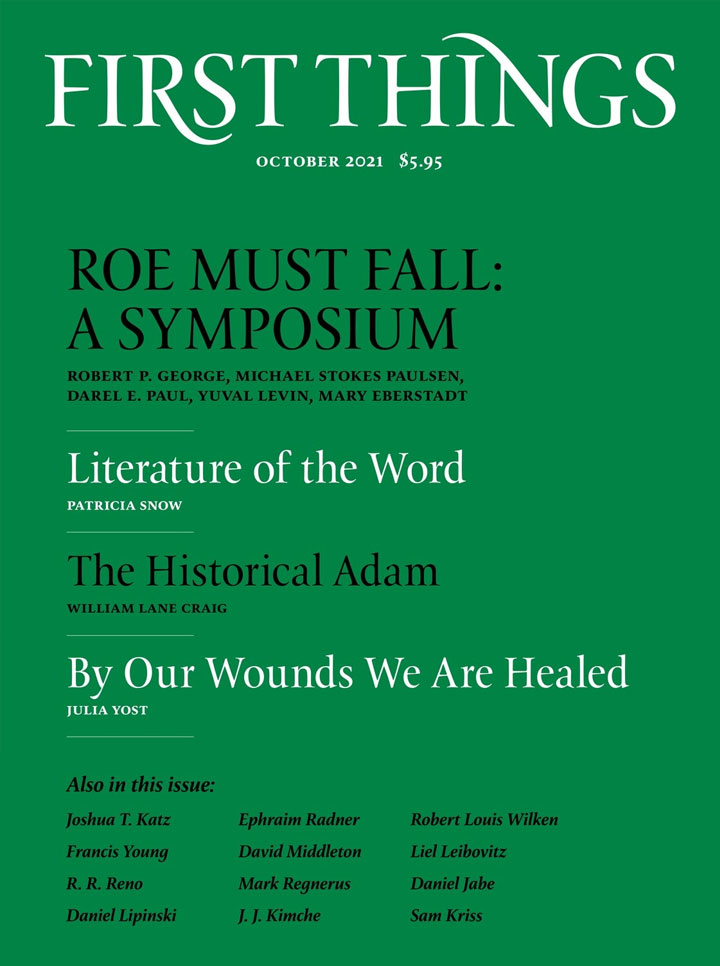I painted to be loved.” That is how the artist Francis Bacon (1909–1992) described his impulse to create. Bacon’s work came to be part of the canon of late twentieth-century British painting, hanging in major museums around the world. His brutal images of contorted bodies, slabs of meat, and screaming popes, with their washed-out colors flowing away like diluted bodily fluids, are often linked to the nihilism of an atheistic, postindustrial existence. All this, Bacon said, from a desire to be loved.
That Bacon was an atheist is beyond doubt. Christians often dislike atheists: dismiss them, rail against them, fear them. But not all atheists are alike. Not all are enemies of faith.
Some bear witness to an unquenchable desire within, in which grace abounds. They know what is good but cannot grasp it.
Bacon is one whose unbelief was “tragic.” It subverted what he knew in his heart to be true. But in this thwarting, there is for us a revelation to which we should humbly attend. After all, many Christians have simply forgotten what a deep desire for God really is, and how it stretches our souls with an almost agonizing patience.
Not all atheists are “tragic,” of course, at least not in their own self-construction. Some atheists are quite happy, even as happiness remains bound to the most superficial hopes and arrogant delectations. The tragic atheist truly suffers. There are some whose consciences have been hollowed out by a sense of social loss, and they often bitterly mourn the disappearance of what may once have been a vital Christian civilization, now dissolved. Perhaps the philosopher John Gray falls into this category (as one reporter on atheism, the Finnish theologian Olli-Pekka Vainio, argues). But disillusioned cynicism is not “tragic,” only uselessly unpleasant. The tragic atheist must endure something more profoundly afflicting. He is someone whose deepest desire, shared with all human beings—the desire to be loved—is fundamentally stymied.
The atheist who simply rejects what the Christian desires is not interesting. But the tragic atheist desires, and ever desires, yet cannot tolerate the longing and, dare we say it, pain. So, he repudiates altogether, with a hoarse admission, desire’s fulfilment. This marks a deep insight, because the tragic atheist has apprehended the infinite value of a human person’s purpose, and just in this infinite yearning cannot trust its possibility. Here, in a flash, is the sense of realism to which every Christian must continually turn. Augustine writes, “The entire life of a good Christian is in fact an exercise of holy desire. You do not yet see what you long for, but the very act of desiring prepares you, so that when he comes you may see and be utterly satisfied.” The preparation for God’s gift is itself a hard grace: It is also the way by which all things find their glorious end.
Tragic atheists are partners in Christian purpose. In this sense, Nietzsche has nothing tragic about him. His view of tragedy, laid out in The Birth of Tragedy, was deliberately a-Christian (not even deigning to be anti-Christian). According to Nietzsche, a life of conflicted, conflicting, and variously unfulfilled desires is perfectly fine, precisely in its irresolution. He cared nothing about satisfaction. Christianity’s yearning and sense of incompleteness was his enemy. By contrast, the tragic atheist is one who cannot help but yearn for God, yet cannot or will not recognize the gift, or faints before its incomprehensible breadth. As Christians, who often end up going through the motions, we can learn from this yearning. On some level it ought to be our own, its stark lines of abandoned isolation illuminated by the tragic atheist.
The work and life of someone like Francis Bacon—and of other tragic atheists, in their quite diverse characters, from Gabriel Fauré to Hannah Arendt to Maurice Sendak—display the nature of true desire from the vantage of its painful limitation. They guide us toward the longing perseverance that marks the truth that our lives are God’s utter gift.
Bacon’s infamous crucifixes and popes can confuse and disorient. From one perspective, they are formal schemes drawn from the masters, Grünewald and Velázquez. From another, they are symbols of religious denial, whose distortions represent rejection. But Bacon himself hinted at their positive assertion. He explained that crucifixion has to do, in part, with the violence and death of human life taken as a whole, demoted to the condition of beef hanging on hooks. “We are all meat,” he pronounced. That is a comment on life, of course, but life in its aspect of sorrow. True life is something we desire. But apart from God, life is deadened matter—dust and ineluctable disappointment.
Bacon, in his own telling, was “obsessed” with death, “terribly” so:
Once when I was fifteen or sixteen years old I saw a dog peeing and I realised at that moment that I was going to die. I think there is an equally important difficulty in man’s life. The moment when you discover that youth does not last for ever. I understood it that day. I thought about death and since then I have thought about it every day.
The dog’s urination, the pointless dissipation of a living being’s inner springs, somehow triggered a sense of terror. As the years went by, Bacon found himself caught in a “net between the fear of living and fear of death.” This, he noted, impels a “scream,” a motif that reappears again and again in his paintings and that defines a human being’s coming into existence at birth.
One can compare Bacon’s images with those of Chaim Soutine (1893–1943), the Jewish, Russian-French painter, whose interest in “flesh,” rendered in the depiction of animal carcasses, may seem analogous to Bacon’s. But Soutine’s deeply rooted Jewish identity and intuitions allowed him to approach the dying and dead animals he painted with a religious sensibility of compassion. His sympathies were based on what he had learned about God’s creative relation to the lives he had made, in joy and sin both. Soutine may have lost his youthful orthodox beliefs, but his vibrantly fluid and colored images always affirm the miracle of divine grace and never signal destruction. Soutine could talk about some deep “cry” within him struggling to emerge in the face of creaturely existence. There was nothing sentimental about his own painful death while on the run from the Gestapo. Yet, unlike Bacon’s “scream,” Soutine’s cry was a wail filled with love grasped rather than yearning frustrated.
Bacon seemed chained within the dynamics of death, violence, and sex (with men especially). His paintings were filled with homoerotic yearnings that have about them always the most agonized of frustrations. In this regard, if in a different register, he was like Foucault, whose inner demons gave rise to an often exquisite jouissance of detailed erudition that seemed to mask the unrealized desire “to be loved.” With Foucault, the dynamic produced an entire philosophy of barely controlled (and hardly believable) “self-care,” the redoubt of those who cannot find or give the love they crave.
But note well: There is nothing cynical here, for either Bacon or Foucault. We see only desperate self-protection and naive vulnerability, which Foucault’s own demise seemed to embody and Bacon’s bizarre and violent sexual life enacted. Tragic atheists cannot do away with tears, however much they try. It is the failed effort to put an end to the desire to rest in love’s embrace that makes them tragic, for this form of weeping, instead of lasting “for a night” (Ps. 30:5), seeps out into the seasons of before and after, drowning the landscape in a sodden flood.
Christians, too, must weep. Our weeping, however, is a kind of ensign. It leads forward, cleanses, empties, prepares. Augustine’s commendation of “holy desire” speaks of desiring (desiderium) as a “stretching,” of our lives distended and opened up, prepared to receive. Longing is a life being readied, because the love of God is never simply a reward; it is always an “already,” pressing into and widening our small hearts, often dragging us with desire’s relentless pull. Francis Bacon was in that sense loved long before he picked up a paintbrush. He lived under the hard press of life and in its hard ruts. The tragedy comes from the fact that desire’s anguish could never offer its own fulfillment—but only the panting of love’s deepening.
Such deepening is a goal, worth traveling along Bacon’s ruts to reach. Augustine saw the Christian vocation as a pilgrimage. To paint as a pilgrim is a noble artistic goal, rarely attained, certainly not by Bacon, who would not allow himself a vision of its end. But the impatience of so many Christians, of the Church herself, can itself be an impediment to a tragic atheist like Bacon, a false ensign, a scandal. We have much to learn: “O Israel, wait for the Lord. . . . He will fulfill the desire of them that fear Him” (Ps. 130:7; 145:19). Waiting in desire, desiring in waiting: Here is the form of redemption from all tragedy.
Ephraim Radner is professor of historical theology at Wycliffe College.
Image by Martin Beek via Creative Commons. Image cropped.
Tunnel Vision
Alice Roberts is a familiar face in British media. A skilled archaeologist, she has for years hosted…
The German Bishops’ Conference, Over the Cliff
When it was first published in 1993, Pope St. John Paul II’s encyclical on the reform of…
In Praise of Translation
The circumstances of my life have been such that I have moved, since adolescence, in a borderland…



